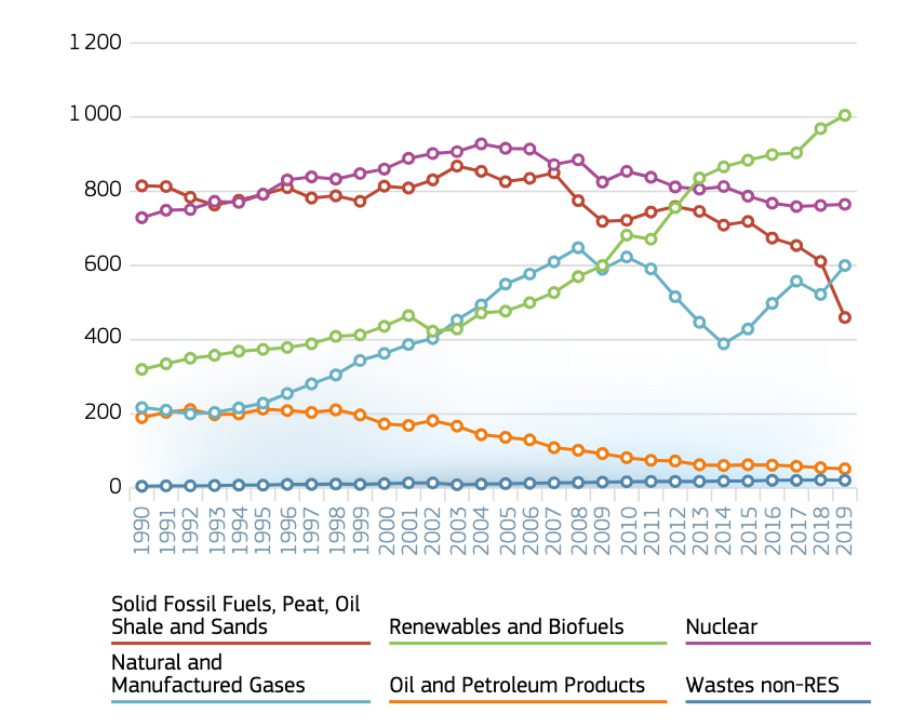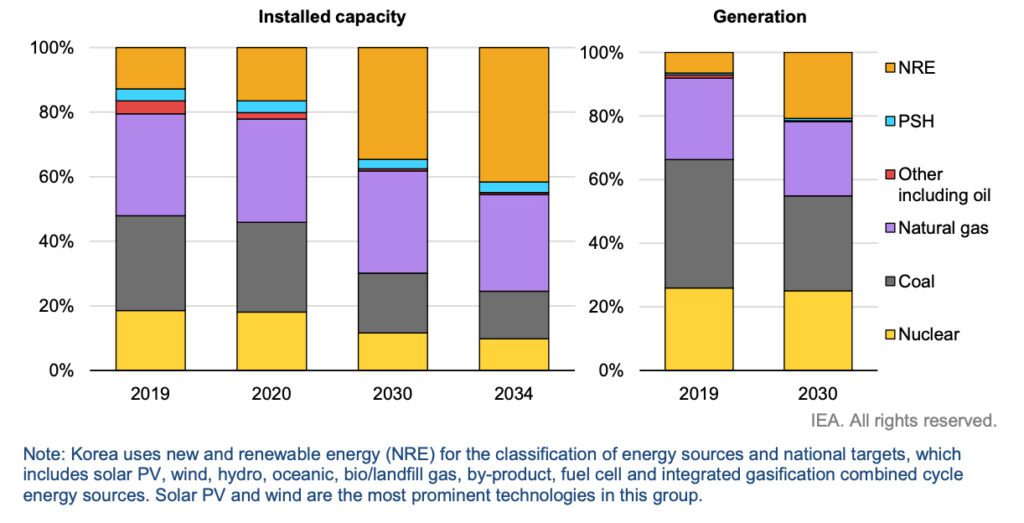Nuclear and Natural Gas Taxonomy Battles Brewing in Europe and S. Korea

A leaked draft of the European Commission's proposal to label some natural gas and nuclear power plants as transitional" or green" investments has prompted pushback from some European Union (EU) members. Criticism is also mounting in South Korea, where liquefied natural gas (LNG) was included in its new green taxonomy guidelines-but nuclear was left out.
Battles about green" taxonomy are rallying given their potentially significant influence on green finance. A taxonomy is essentially a document, usually binding, that serves to define factual and science-based views on the sustainability of an asset class. In other words, it creates a common language" that investors can use to determine which sustainable project and economic activities the market needs to meet climate and environmental objectives.
In the EU, for example, taxonomy regulation is being designed to encourage capital allocation to corporate environmental objectives over the next 30 years to 2050. But taxonomy could also apply to public funding, designating, for example, which projects may be eligible for certain public finance. Companies around the world are meanwhile also voluntarily relying on these green lists" in adopted environmental, social, and governance (ESG) criteria, which are embedded in sustainability and transition strategies.
EU Mulling Inclusion of Gas and NuclearIn Europe, the taxonomy debate intensified on Jan. 1, after the European Commission announced it had begun consultations with member states on a draft text of a Taxonomy Complementary Delegated Act" that includes certain gas and nuclear activities. The complementary" act, which the Commission expects to formally adopt in January 2022, is a follow-up to the EU's 2021-adopted Taxonomy Delegated Act. The first part qualified several power-producing sectors in its technical screening criteria but delayed controversial decisions on gas and nuclear to provide more time for technical assessments and public feedback.
According to several media outlets that this week received a leaked version of the Commission's proposal, the governing body is looking to label nuclear power and some gas investments as green. Nuclear plants must have a plan, funds, and a site to safely dispose of radioactive waste, and new nuclear plants must receive construction permits before 2045, EURActiv suggested.
Reuters reported that investments in natural gas power plants would also be deemed green" if they produce emissions below 270 grams of CO2 equivalent per kWh, replace a more polluting fossil fuel plant, receive a construction permit by Dec. 31, 2030, and plan to switch to low-carbon gases by the end of 2035.
The taxonomy proposal notably echoes proposed rules and directives unveiled by the European Commission on Dec. 15 that seek to create conditions for a shift from fossil natural gas to renewable and low-carbon gases, mainly biomethane and hydrogen. The Commission's decarbonized gas initiatives could establish a hydrogen market-including for its trade and infrastructure-in two phases, before and after 2030. In that set of proposals, the European Commission defined renewable gases as gases that are produced from biomass and hydrogen produced from renewable sources. It defines low-carbon" gases as gases that produce at least 70% of less greenhouse gas emissions than fossil natural gas across their full lifecycle."
 Gross electricity generation for the European Union's 27 members by fuel from 1990 to 2019 in TWh. Source: EU Statistical pocketbook 2021.
Gross electricity generation for the European Union's 27 members by fuel from 1990 to 2019 in TWh. Source: EU Statistical pocketbook 2021.
The EU's taxonomy proposal has the backing of France, which gets about 70% of its power from nuclear, along with the Czech Republic, and Finland. Slovakia also welcomed the proposal. Austria, however, reportedly has already ordered a legal opinion over nuclear's inclusion in the taxonomy. Political opinion in Germany, which on Dec. 31 shut down three of its last six nuclear plants, is reportedly split within the new German coalition government.
FORATOM, the European nuclear trade organization, on Tuesday welcomed the proposal, though it said the industry was still reviewing the conditions of this leaked text in order to identify its impact on the sector." It added: "Nevertheless, we do not believe that #nuclear should be treated as a transitional technology as it clearly contributes to climate mitigation objectives and does not cause more harm than any other power-producing technology already considered as taxonomy compliant."
ETN Global, a gas turbine technology membership association, in a Dec. 22 letter to the European Commission welcomed the recent decarbonized gas legislative package, but it urged caution on initiatives that could curb technology investments.
The EU taxonomy's role here is decisive: too tight initial CO2 limits for combined heat and power plants and gas-fired power plants will not only make it more difficult and costly to finance the energy transition path but will also penalize those companies on the financial markets who are keen to secure the transition," the organization said. To support and accelerate the transformation of the energy industry in Europe, it is crucial that plants, which comply with a gradual reduction of emissions over time (sunset clause) will be classified as EU Taxonomy-aligned in the forthcoming Complementary Delegated Act."
South Korea Includes LNG in Green List GuidelinesIn South Korea, the Ministry of Environment's Dec. 30-released guidelines on K-taxonomy" excluded nuclear energy but included LNG. The guidelines, which the ministry said were prepared with technical consultation and public feedback over two years, will promote green finance, support the flow of private and public funding into green projects and technologies, and prevent damage caused by greenwashing, such as excessive and false information."
Along with its inclusion of renewable technologies, including solar power and solar heat, the guidelines say LNG power plants and plants that use mixed gas" comprising LNG and biogas, hydrogen, ammonia, or by-product gas will be considered low-carbon" until at least 2030. The guidelines will temporarily support LNG power plants whose greenhouse gas emissions are within 340 grams of CO2 equivalent/kWh based on design specifications. They also include gas plants that plan to reduce their intensity to achieve, over their average design life," 250 grams of CO2 equivalent/kWh. K-taxonomy also includes carbon-neutral fuel, carbon capture, utilization, and storage (CCUS) technology. Blue hydrogen will be included until at least 2030.
South Korea's 9th Basic Plan for Long-term Electricity (BPLE) foresees an increase in the share of new and renewable energy generation-7.4% today to 20% in 2030 and 30-35% in 2040. As the country increases its renewables share, it anticipates a reduction in the share of nuclear and a ban on new coal-fired generation.
A September 2021-released report jointly written by the International Energy Agency (IEA) and the Korean Energy Economics Institute at the request of the Ministry of Trade, Industry, and Energy suggests South Korea will need to boost its flexibility requirements as its share of dispatchable generation falls from 94% to 79% through 2030. The 9th BPLE, notably, envisions converting much of its existing coal-fired generation to liquefied natural gas. Of the coal plants over 30 years old, 30 are already approaching the age of retirement, but 24 of these (12.7 GW) are expected to be replaced by new [combined cycle gas turbine] plants," the report says.
 Evolution of installed capacity and generation, according to South Korea's s 9th Basic Plan for Long-term Electricity. Courtesy: IEA/Korea Electricity Security Review (2021)
Evolution of installed capacity and generation, according to South Korea's s 9th Basic Plan for Long-term Electricity. Courtesy: IEA/Korea Electricity Security Review (2021)
Pushback against the K-Taxonomy measure has been mounting since the country released its draft green taxonomy guidelines in November. The obvious dichotomy here is that recognizing gas and LNG as an environmentally sustainable transition' fuel will likely lock South Korea into a high-emitting future, which directly contradicts the policy and market incentives created by President Moon's new emissions reduction targets," Christina Ng, Research and Stakeholder Engagement leader at the Institute for Energy Economics and Financial Analysis (IEEFA) wrote in a blog post. This means that new unabated LNG-power projects, of which around 10 gigawatts are expected to flood South Korea's energy market by 2025, would qualify for green bond and loan financing if the draft K-Taxonomy is finalized without changes."
Ng suggested that South Korea's inclusion of LNG in its taxonomy echoes efforts by other countries in Asia. China, which is the largest green debt market in the region, has however recognized the significance of a truly green taxonomy," she noted. In mid-2021, China removed fossil fuel-related projects and the new Green Bond Endorsed Project Catalogue-its equivalent green taxonomy-now excludes gas, LNG and coal-fired power activities," she said.
-Sonal Patelis a POWER senior associate editor (@sonalcpatel,@POWERmagazine).
The post Nuclear and Natural Gas Taxonomy Battles Brewing in Europe and S. Korea appeared first on POWER Magazine.